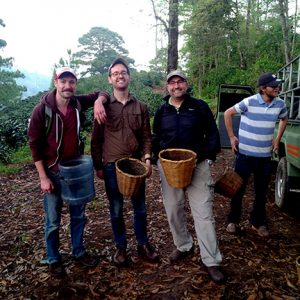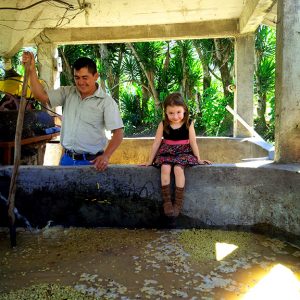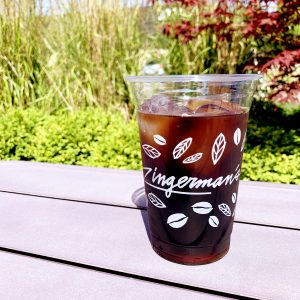High-Grown Honduras Coffee from Farmer Pablo Paz
A University of Michigan student project pays delicious dividends a decade down the road
Ari Weinzweig, CEO & Co-Founder of Zingerman’s
It’s about ten years ago now that U of M alum Andrew Boyd approached me. He wanted to tell me about a new project he and some other recent graduates were getting into. Their idea was to work with quality-oriented specialty coffee growers in Honduras to enable the farmers to sell their beans for a much higher price and free themselves from the mass market’s unmanageable price swings. By having us roast the coffee and sell it here at Zingerman’s, he suggested, we could bring it back home to Ann Arbor—whence this wonderful project originated. A decade down the road, I can confidently say the project with the company Andrew and his colleagues call Union Microfinanza is going strong. The Honduran coffee this year is better than ever—right now it’s featured as the Coffee of the Month. The crew at the Coffee Company says it’s “floral and juicy, with notes of cocoa.” I agree. Add maybe a touch of toffee or toasted walnuts. And I’ll say too that the finish is cleaner and smoother than ever. I loved the clarity I got when it was brewed as a Chemex. As our partner at the Coffee Company, Steve Mangigian, shared, “It shows that when you work with the producer year after year, and when everyone is committed to quality, it gets better and better each year.”
The land of the nation-state now known as Honduras has been inhabited for thousands of years by various native tribes, including a strong presence of Maya (the border to the north is Guatemala). Europeans arrived at the end of July 1502. Columbus named it Honduras, which means “depths,” for the deep waters of the harbor. Native tribes fought back against the Spanish for much of the 16th century and maintained a fair bit of freedom from European colonizers through the 17th century. In the 17th century, a number of Africans destined for enslavement escaped from slave ships that had wrecked on Honduras’ rocky Gulf coast. Many intermarried with native peoples and their descendants came to be known as the Miskito people. By the end of the 18th century, the Miskito kingdom was quite well established. They had an interesting and very egalitarian culture—Miskito kings sat on the throne, but all members of the kingdom were considered to be equal and the kings had very little power unless the kingdom was being attacked. In one of those seeming incongruities and complexities that make historical oversimplification inevitably ineffective, the Miskito often raided other territories and sold their captives to the English as slaves to be brought to work in the Caribbean sugar fields.

Chris, Matthew, and Managing Partner Steve Mangigian picking coffee cherries in Honduras, during the the trip to origin in 2015.
If you look at a map, you’ll find Honduras lies at about the midpoint of Central America, nestled nicely between Nicaragua to the east, Guatemala to the west, and El Salvador to the south. Coffee came to the area in the late 19th century, but since bananas remained the big colonial cash crop, coffee got little attention. Coffee for high-quality export really only started up in the years after we opened the Deli in 1982. Before that, the best Honduran beans were sold across the border and repacked as Guatemalan coffee in the same way that olive oil from North Africa was long shipped to Italy and re-packaged there.
A crew from the Coffee Company flew down to Honduras back in the winter of 2015 to visit. The farmer, Pablo Paz, won their hearts with his commitment to quality, his family’s five generations in coffee growing, and his interest in learning and continuous improvement. The crew shared: “Long before many folks in the specialty coffee world were paying a premium for high-quality beans or taking trips to remote areas of the world to source rare and distinct micro-lots, growing fantastic coffee was just how the Paz family operated, and we’re so lucky to have developed a relationship with him.” Pablo’s farm is located in the hills outside the town of La Union, in the highlands, in the center of the country. The town is doing well, in great part thanks to the attention and income that comes from being a central point for high-quality coffee.
Pablo Paz’s Honduran beans brew up in what I would suggest is an exceptionally egalitarian cup—a set of more forward flavor notes for those who like their coffee on the bolder side, yet simultaneously soft enough for people like me who prefer their brew to be mellower. You can get Pablo Paz’s Honduran coffee at the Coffee Company, Deli, and Roadhouse!
Excerpt from Ari’s weekly Top 5 E-Newsletter. To stay in-the-know about things that Ari is excited about in the Zingerman’s family, sign up here!
Kyoto Cold Brew Coffee
400 years of Japanese tradition and 10 hours of patience add up to one smooth cup of cold brew coffee.
What is Kyoto Cold Brew Coffee?
Kyoto-style cold brew coffee is made by letting cold water slowly drip, drop by drop, over coffee grounds. Kyoto cold brew, or Kyoto drip coffee, is also known around the world as Dutch coffee, ice drip coffee, cold drip coffee, and water drip coffee. It is documented as far back as the 1600s in Japan, where it’s believed the method was introduced by Dutch traders who brought cold brew on their ships.
Kyoto Is Cool
The traditional Kyoto drip method, like all cold brew coffee, is made using cool water instead of hot water. The use of cool water changes the balance of flavors extracted from the coffee grounds during brewing. Kyoto drip coffee barely oxidizes, which makes it easy to taste the subtlest flavors and nuances of single origin coffees. It is an especially good brewing method for lighter-roasted coffees, as it preserves the nuances and bright, fruit-like flavors of more delicately roasted, complex beans.
The sight of a Kyoto-style brewer is something to behold! The four foot tall wood and glass tower is a cross between an elegant hourglass and an intriguing chemistry set. It has three sections: the water chamber on top, the column of coffee grounds and filter in the middle, and the carafe at the base. And, you get to drink the experiment with no dire (only delicious) consequences!
Zingerman’s Coffee Company guests will have the chance to try Kyoto Cold Brew for a limited time. We have our very own Kyoto brewer, and will offer this unique cold brew for the whole month of August – exclusively in our Southside cafe!
Kyoto Cold Brew at the Zingerman’s Coffee Café
- 300g coffee beans, ground medium-coarse
- 3000g cold-filtered water
- 1 drip per second
- Duration: 10 hours
- Final product is served over ice, your choice of short or tall!
Other Cold-Brewed Coffee Options
For those who’d like to taste their way through Zingerman’s cold coffee offerings after they try Kyoto Cold Brew, we recommend sampling Zingerman’s Cold Brew and Nitro Cold Brew.
- Zingerman’s Cold Brew is brewed by completely submerging coarse ground coffee in cool water for 12 or more hours, which results in a finish with less acidity than Kyoto Cold Brew.
- Next, try our nitro cold brew, which is Zingerman’s Cold Brew infused with nitrogen gas and served on tap. Nitro cold brew has a rich, creamy head you may recognize from nitro draft beers like Guinness.
Curious about Coffee? Sign up for our monthly e-newsletter to be the first to know about classes, events, new coffees, and more!



